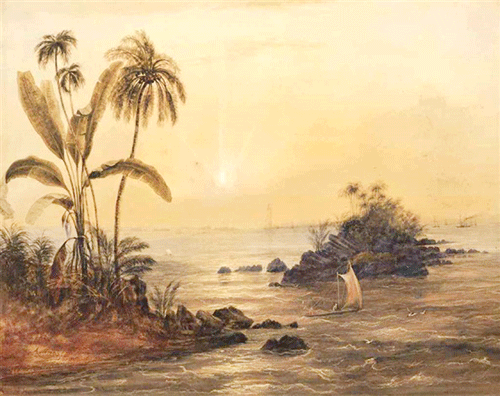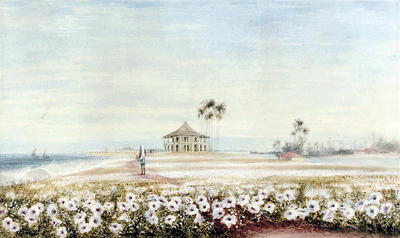Art teacher and much more at Ceylon Academy

The lighthouse and harbour in Galle
Within a month after arriving in Galle in September 1846, while awaiting his teaching assignment at the Colombo Academy, Andrew Nicholl set to work on a series of botanical illustrations focusing on the common flowers and fruits along the coastal district, The first sketch of a group of coconut palms was dated as early as October 1846 and the last in July 1849.
The Colombo Academy in which Nicholl was appointed as an art teacher was founded in 1835 and was originally at Messenger Street, Pettah. During Nicholl’s tenure at the school, it had moved to Second Cross Street. During this period, the principal was a fellow Irishman, Dr. Barcroft Boake from Trinity College, Dublin. Although the pupils at the Colombo Academy numbered 250, Nicholl’s duties were restricted to 30 to 40 students. Nicholl trained this select number of students in topographical and mechanical drawing preparing them as suitable candidates for the Government’s own Department of Surveys. The Schools Commission firmly believed that this approach to training students would enable them to achieve a certain level of excellence, not so much to become artists but to use their skills in topographical drawing to work in the Public Works Department and Survey Department both of which were heavily under-staffed.
As The Young Ceylon (1851), a journal devoted to the arts pointed out in a review until the arrival of Nicholl, no artist had previously worked in watercolours. Nicholl was one of the first to introduce this medium to this country. Further confirmation of Nicholl’s contribution was the Report of the Schools Commission for 1846-47 which stated, “Mr Nicholl is at once an artist and a teacher of such ability it is rare to be expected in the colony.”
The instructions provided in his art classes were so appreciated by the school authorities, that it was decided to admit students from other schools as well as personnel from other Government departments. This move encouraged the Schools Commission to establish a School of Design and Drawing to widen the scope of instruction to assist artisans and craftsmen.
A bound volume of sketches presented to the British Museum in 1883 by Nicholl of copies of specimens for design work training gives some idea of the type of instructions given at the school. Bound with it are a few specimen copies of the students’ work, including a few select examples drawn by one of his pupils – a Mr. Coomaraswamy This is most likely Muttu Coomaraswamy, the father of Ananda Coomaraswamy, the eminent art historian and author of Medieval Sinhalese Art (1908).
On August 3, 1847 Nicholl and Tennent were invited to visit the site of the capture of elephants in “Kraal” or stockade. This event was held in honour of the newly posted Governor of the Colony, Lord Torrington in the forest close to Kimbulwana Oya, a branch of the Deduru Oya, in the Puttalam District.
These exciting events introduced Nicholl to another facet unfamiliar to him – Ceylon’s rich wildlife. Not only did Nicholl produced several watercolours of this exciting event, many of these scenes of the capture of elephants were later reproduced as wood engravings from his original sketches and published in The Illustrated London News both in 1849 and 1850.
Five week tour
Although 1848 proved a disastrous year for the colony and civil disturbance was rife, it ironically turned out to be the most exciting period of Nicholl’s career. Nicholl was invited with three others to accompany Colonial Secretary Emmerson Tennent in the five weeks between July and August on a tour through one of the most dramatic landscapes in the country including some monumental archaeological structures thousands of years old.
The extracts from Nicholl’s article in the Dublin University Magazine recount the adventures he experienced and the exuberance with which he responded to the dramatic landscape and rich tropical vegetation.
Nicholls vividly described the first few days of the journey leaving Colombo and approaching the Bridge of Boats over the swiftly flowing Kelani Ganga-‘The road runs parallel with the Kelani Ganga and to the Bridge of Boats. Scenery beautiful sylvan character its banks being lined with rows of Jack and teak trees. Passing native gardens, while the gliding river is seen through their tall, graceful stems sparkling in the gorgeous light of a tropical sun.”
Nicholl’s watercolour (now on view at the National Museum) vividly captures this pontoon bridge which was discarded in 1896 and replaced with a lattice steel bridge.
Nicholl only had praise for Ambepussa rest house. He wrote –‘…where there is an excellent rest house embosomed in the heart of an amphitheatre of mountains.’ The winding road rising to a steep gradient to Kaduganawa-Nicholl compared to the famed pass in Switzerland- ‘Simple on pass of the east which is a gradual ascent of three miles presenting a scenery unequalled in in variety and grandeur-the sublime landscape.’
Kandy offered Nicholl some excellent landscape views for his watercolours ‘The finest and most picturesque view of Kandy is obtained from the hills on the opposite side of the lake’ and he painted at least ten separate large works. Further on the road from Kandy to Dambulla he paused at Alu Vihare, the huge granite boulders of which he executed several sketches and watercolours. He wrote, ‘The celebrated temple called Alu Vihare situated under the shelving portion of a huge mass of granite rocks, which have been hurled by some convulsion of nature, from the summit of one of the mountains … which to the spot where King Walagam Bahoo, ninety two years before the birth of Christ assembled the priests to commit the doctrines of the Buddha to writing which formed the Bunupota or Buddhist Bible.’
On the road to Polonnaruwa in the neighbourhood of Akuna, Nicholl stumbled upon scattered ruins, which he identified as Wijithapura, and described it as a transient staging post, before Polonnaruwa was established as the capital. The stone columns, granite steps and guard stones which he documented so intricately have been buried by the jungle and swamps and have not been traced.
Of all the sites he visited it was Polon-naruwa and its monuments that enthralled him. His watercolours and sketches, of the Watadage, Satmahal Prasada and the Stone book beside it, Thuparama, GalVihare, were delicately sketched and turned into impressive watercolours. In Mihintale, he observed of one of the rock cut monastic cave with granite ledges “not unlike St. Kevin’s bed.”
Nicholl’s approach to
documenting antiquities
Often in his drawings of temples and buildings, he would sketch lightly over his compositions, drawing a pencilled outline of the image, laid out over with a flat transparent wash in colour picking out the essential in white. This was a highlighting technique using whiting or, scraping out with a knife to expose patches of white, which watercolour technique he may have borrowed from Turner. Often this device further heightened the image giving the effect of foam, sailing boats or sea birds (in his Galle Bay seascapes) set against a background of the brilliant bluish green of the sea. Occasionally he would introduce one or two human beings with very bright garments (such as the priests in their yellow robes in the water colour of Alu Vihare) positioned in the middle ground.
But more often Nicholl’s rendering of the human form was weakly executed.
His favourite paper on which his pencil sketches of Sri Lankan subjects were executed was a special one which was of a buff tinted colour.
Though his early Irish works in the 1820s-30s were more mellow and sombre, his palette here was much brighter. Many of these watercolours glowed exquisitely; modulated with greens, blues and reds while capturing the picturesqueness of the country’s scenery. The sunrise and sunsets in Galle across the bay best epitomise his artistic treatment – in the watercolour medium often imitative of the power of oil paint.
This trademark style would was to persist throughout his career with some subtle modifications. He would frame most landscape views with a fringe of flowers (Convolutes sp.) and invariably the foliage placed in the lower quarter of the foreground at the bottom edge of the picture.
Return to Britain
Although Nicholl was relieved of his duties as a teacher at the Colombo Academy at the end of 1848 or early1849, he stayed on till April till he managed to book a passage home.
Very little is known about Nicholl’s activities in England and Ireland after he left Ceylon. He continued to work as an artist both in Dublin and London occasionally exhibiting at the Royal Academy including an item titled The Palace of Parakrama Bahu.
About 1858 he was touch with his Belfast friend Emmerson Tennent, in England who had left Ceylon in 1850. Tennent’s first book Christianity in Ceylon (1850) had numerous woodcut prints based on drawings by Nicholl.
Writing to Nicholl on March 1859, regarding an illustration (Noosing wild elephants) for his latest work the two volume on Ceylon, its history etc.which had gone to the press at Longmans, the publishers, Tennent made this request; ‘Now it occurs to me that you may have some rough sketches that would enable Wolf to make the foregrounds in character with Ceylon vegetation and if you hand them to me for that purpose, you see what an advantage it would be to me.’ Nicholl delivered them to Tennent’s address in London.
This with 28 other drawings by Nicholl were published as wood engravings in Tennent’s two volume work, which was an immediate publishing success. As many as five editions were issued by Longmans between 1859-1860.

A view of Galle Face Colombo
In 1870, Nicholl submitted 12 watercolours to Queen Victoria and two were purchased. In June 1872 he was invited for an exhibition on arts, industries and manufacture in Dublin.
Andrew Nicholl died in April 1886, aged 83 at his house in 7, Camberwell Grove. London. In May 1886 a month after Nicholl’s death, a large commemorative exhibition was held at 55, Donegall Place, Belfast organized by William Nicholl, perhaps son of James, Andrew’s brother. As stated in the catalogue this exhibition was “to vindicate the reputation of the late Nicholl as an artist of no mean order”. On display were 280 items, of which were 55 botanical works in watercolour. A century afterwards in 1981, 48 of these botanical sketches were on exhibition at Spink & Son, London.
In 1889, Nicholl’s daughter Mary Anne Nicholl presented 56 watercolour sketches of tree and plants of Ceylon to the Royal Hibernian Academy in memory of her father. This detailed and extensive collection of drawings and watercolour paintings on all aspects of the Sri Lanka’s archaeology, botany, and history indicates the affection and interest Nicholl had in this country.
In the recent past, several dozens of Nicholl’s sketchbooks, drawings, and paintings have turned up at the sales rooms and galleries of Sotheby’s, Christie’s and Spinks in London- and many of them include images connected to Sri Lanka. Nicholl’s legacy is best justified in the long list of artists the former Colombo Academy, now Royal College, has produced, no doubt built on the foundation he put in place.


